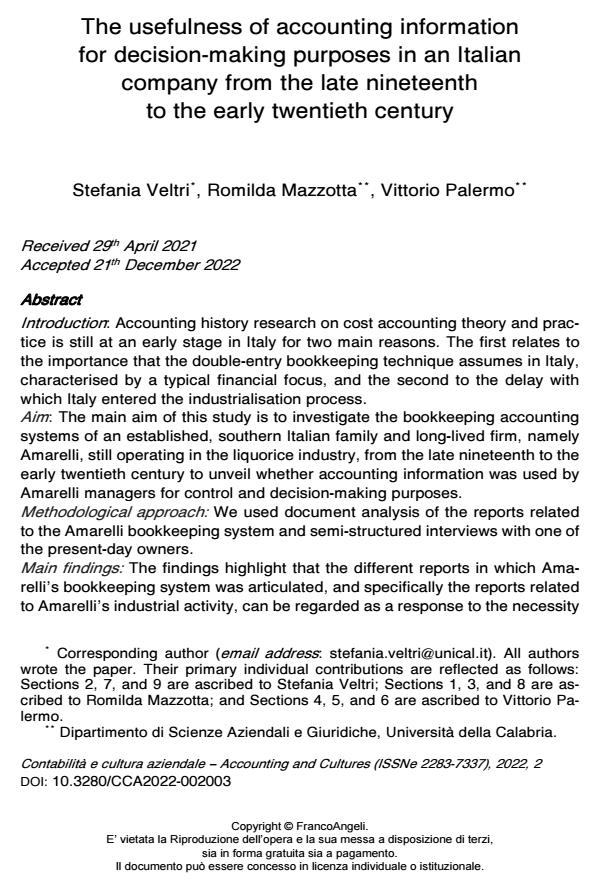The usefulness of accounting information for decision-making purposes in an Italian company from the late nineteenth to the early twentieth century
Titolo Rivista CONTABILITÀ E CULTURA AZIENDALE
Autori/Curatori Stefania Veltri, Romilda Mazzotta, Vittorio Palermo
Anno di pubblicazione 2023 Fascicolo 2022/2
Lingua Inglese Numero pagine 24 P. 29-52 Dimensione file 180 KB
DOI 10.3280/CCA2022-002003
Il DOI è il codice a barre della proprietà intellettuale: per saperne di più
clicca qui
Qui sotto puoi vedere in anteprima la prima pagina di questo articolo.
Se questo articolo ti interessa, lo puoi acquistare (e scaricare in formato pdf) seguendo le facili indicazioni per acquistare il download credit. Acquista Download Credits per scaricare questo Articolo in formato PDF

FrancoAngeli è membro della Publishers International Linking Association, Inc (PILA)associazione indipendente e non profit per facilitare (attraverso i servizi tecnologici implementati da CrossRef.org) l’accesso degli studiosi ai contenuti digitali nelle pubblicazioni professionali e scientifiche
Introduction: Accounting history research on cost accounting theory and practice is still at an early stage in Italy for two main reasons. The first relates to the im-portance that the double-entry bookkeeping technique assumes in Italy, charac-terised by a typical financial focus, and the second to the delay with which Italy en-tered the industrialisation process. Aim: The main aim of this study is to investigate the bookkeeping accounting sys-tems of an established, southern Italian family and long-lived firm, namely Amarelli, still operating in the liquorice industry, from the late nineteenth to the early twen-tieth century to unveil whether accounting information was used by Amarelli man-agers for control and decision-making purposes. Methodological approach: We used document analysis of the reports related to the Amarelli bookkeeping system and semi-structured interviews with one of the present-day owners. Main findings: The findings highlight that the different reports in which Amarelli’s bookkeeping system was articulated, and specifically the reports related to Ama-relli’s industrial activity, can be regarded as a response to the necessity to calcu-late and control the ‘cost’ of the different ‘processes’ as well as the specific ‘per-formance’ of any single activity of Amarelli, together with the overall ‘perfor-mance’ of the Amarelli factory. Originality: To the best of our knowledge, this is the first study that investigates the accounting systems used by a food industry firm in southern Italy, an under-developed territorial area, from an industrialised point of view during 1875-1925.
Parole chiave:accounting information, decision usefulness, monitoring, decision-making purposes, southern Italy, food industry, case study, liquorice juice, macro- and micro-factors
- A historical comparison exactly one hundred years apart. The global financial crises of 1907 and 2007 and the FIAT case study Stefano Garzella, Rosita Capurro, Stefano Marciano, in CONTABILITÀ E CULTURA AZIENDALE 1/2024 pp.43
DOI: 10.3280/CCA2024-001003
Stefania Veltri, Romilda Mazzotta, Vittorio Palermo, The usefulness of accounting information for decision-making purposes in an Italian company from the late nineteenth to the early twentieth century in "CONTABILITÀ E CULTURA AZIENDALE" 2/2022, pp 29-52, DOI: 10.3280/CCA2022-002003